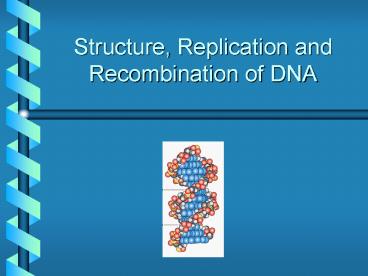Structure, Replication and Recombination of DNA - PowerPoint PPT Presentation
1 / 35
Title: Structure, Replication and Recombination of DNA
1
Structure, Replication and Recombination of DNA
2
Information Flow From DNA
DNA
3
DNA Structure
Primary Structure Chain of Nucleotides
Secondary Structure Double Helix
4
DNA Structure
Nucleotide building block of DNA
- Three components of a nucleotide
- 1. Nitrogen-containing base
- purine or pyrimidine
- 2. 5-carbon sugar
- 3. Phosphate group
5
DNA Structure
Purine bases Adenine (A) Guanine (G)
Pyrimidine bases Cytosine (C) Thymine (T)
5-carbon sugar Deoxyribose
Phosphate PO4
6
(No Transcript)
7
(No Transcript)
8
Chemical Bonding
Covalent Bond Strong Atoms Share Electrons Formation of a Nucleotide
Hydrogen Bond Weak Atoms Share a Hydrogen Pairing of Nucleotide Bases
9
Hydrogen bonds hold pairs of bases together.
10
(No Transcript)
11
DNA Secondary Structure The Double Helix
- Two polynucleotide chains are wound together
- Bases are located inside the helix
- Sugar-phosphate groups are on the outside as a
backbone - Bases are arranged like rungs on a ladder,
perpendicular to the backbone
12
DNA Secondary Structure The Double Helix
- Hydrogen bonding between bases holds the chains
together - A pairs with T
- G pairs with C
- Polynucleotide chains have opposite polarity
- One is 5 ? 3
- other is 3 ? 5
- 10 base pairs per turn of the helix
13
DNA Replication An Overview
14
DNA Replication
DNA replication is semiconservative. Each strand
is used as a template to produce a new strand.
AGCTAGCTAGCT TCGATCGATCGA
TCGATCGATCGA new
AGCTAGCTAGCT new
15
DNA Replication
DNA replication requires 1. DNA
polymerase, an enzyme that adds
nucleotides in a 5?3 direction. 2.
Nucleoside triphosphates 3. Energy release
of diphosphate
5A G C T 3
A 5
G
C
3 T
G
C
T 3
5 A
3T C G A5
16
Origin of Replication
DNA replication begins at a replication origin
and proceeds bidirectionally, creating two
replication forks for each origin. Eukaryotic
chromosomes have multiple origins of replication.
17
Continuous and Discontinuous Synthesis
DNA Polymerase builds a new strand in a 5?3
direction. This leads to continuous synthesis on
the strand oriented 3?5 and discontinuous on
the strand oriented 5?3.
18
Steps in DNA Replication (Bacterial)
- Initiation
- Initiator Proteins bind to replication
origin and cause a small section to unwind.
19
Steps in DNA Replication (Bacterial)
- Unwinding
- Helicase molecules further unwind helix.
- Single-stranded binding proteins keep helix
from reforming.DNA gyrase reduces supercoils
ahead of replication fork.
20
Steps in DNA Replication (Bacterial)
- Elongation
- Primase synthesizes a short RNA strand
primer. - DNA polymerase III adds nucleotides to the
primer in a 5?3 direction.
21
Steps in DNA Replication (Bacterial)
- Elongation
- A single primer is required for leading
strand replication. On the lagging strand, a new
primer is used at the start of each Okasaki
fragment.
22
Steps in DNA Replication (Bacterial)
- Elongation
- DNA polymerase I replaces primer RNA with
DNA nucleotides. DNA ligase seals gaps in
sugar-phosphate backbone.
23
Steps in DNA Replication (Bacterial)
- Termination
- Termination occurs when two replication
forks meet. - E. coli cells have a protein called Tus
that binds to termination sequences and blocks
helicase movement.
24
Accuracy of DNA Replication
- Nucleotide Selection
- DNA proofreading 3?5 exonuclease activity of
DNA polymerase - Mismatch Repair repair enzymes
25
Modes of Replication
26
Differences for Eukaryotic DNA Replication
- Replication Licensing Factor attaches to each
origin, initiator protein only recognizes
licensed origins - Multiple polymerases function in replication,
recombination, repair - Alpha synthesizes primer and a short stretch of
DNA - Delta continues replication on the lagging
strand - Epsilon continues replication on the leading
strand - Topoisomerase enzymes relax supercoils
27
Replication at the Ends of Linear Chromosomes
- Removal of the primer at the end of a linear
chromosome leaves a gap - Linear chromosomes tend to shorten at the
telomeres over repeated cycles of replication
28
Telomerase Extends the Telomeres 3 End
- Telomerase is an enzyme composed of both protein
and RNA - RNA portion binds to the overhanging 3 end of
the telomere, providing a template for elongation - Mechanism for replicating the complementary
strand is uncertain
29
Recombination
30
Holliday Model of Recombination
- Single strand breaks occur at the same
position on homologous DNA helices. - Single-stranded ends migrate into the
alternate helix.
31
Holliday Model of Recombination
- Each migrating strand joins to the existing
strand, creating a Holliday junction. - Branch point can migrate, increasing the
amount of heteroduplex DNA.
32
Holliday Model of RecombinationResolving the
Holliday Intermediate
- Separation of the duplexes requires cleavage
in either the horizontal or vertical plane.
33
Holliday Model of RecombinationResolving the
Holliday Intermediate
- Cleavage in the vertical plane, followed by
rejoining of nucleotide strands, produces
crossover recombinant products.
34
Gene Conversion Occurs with Repair of
Heteroduplex DNA
35
Gene Conversion Occurs with Repair of
Heteroduplex DNA
Gene Conversion can lead to abnormal genetic
ratios.































